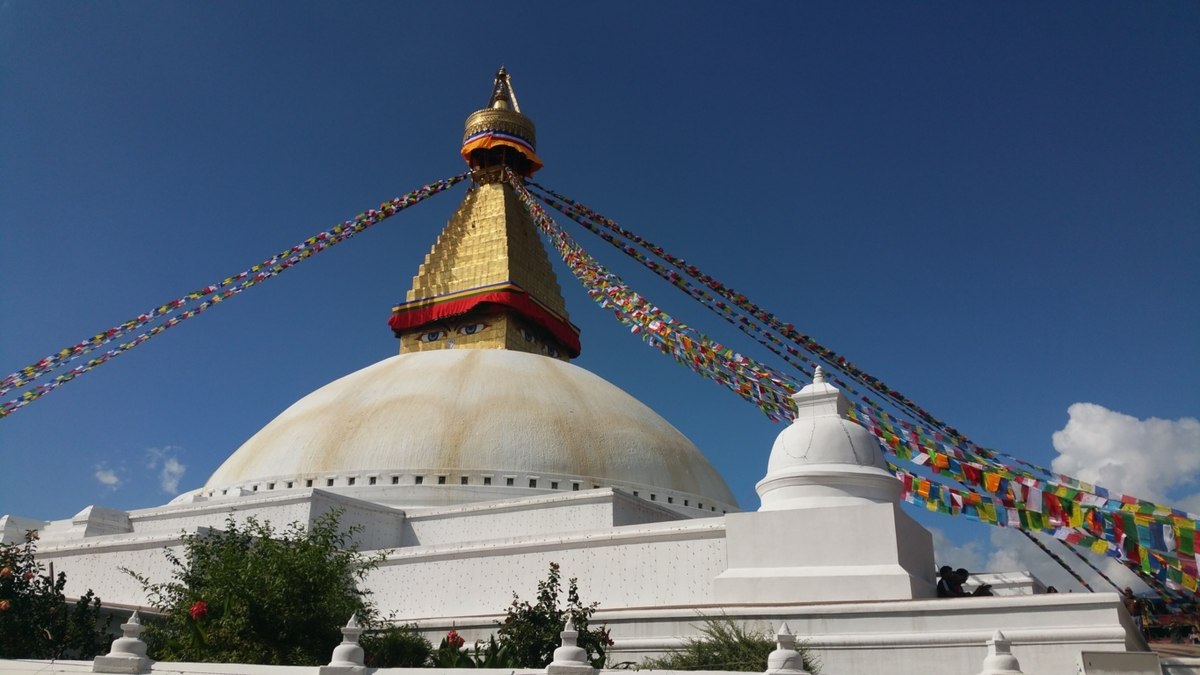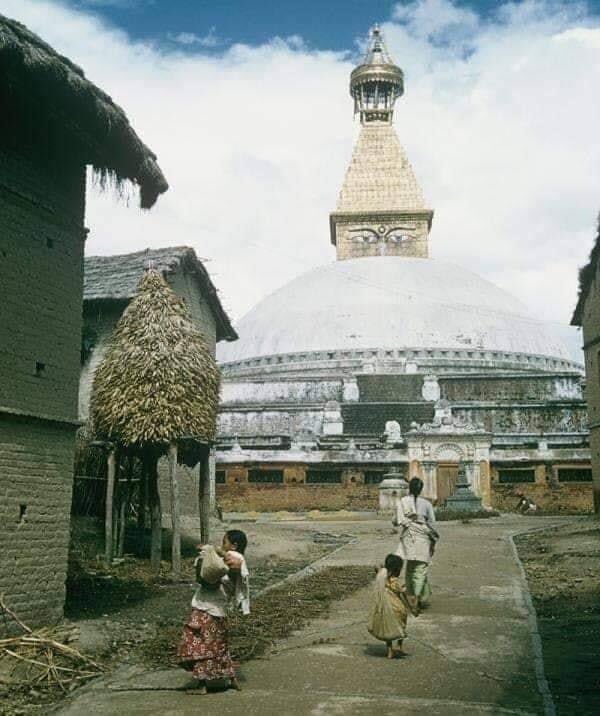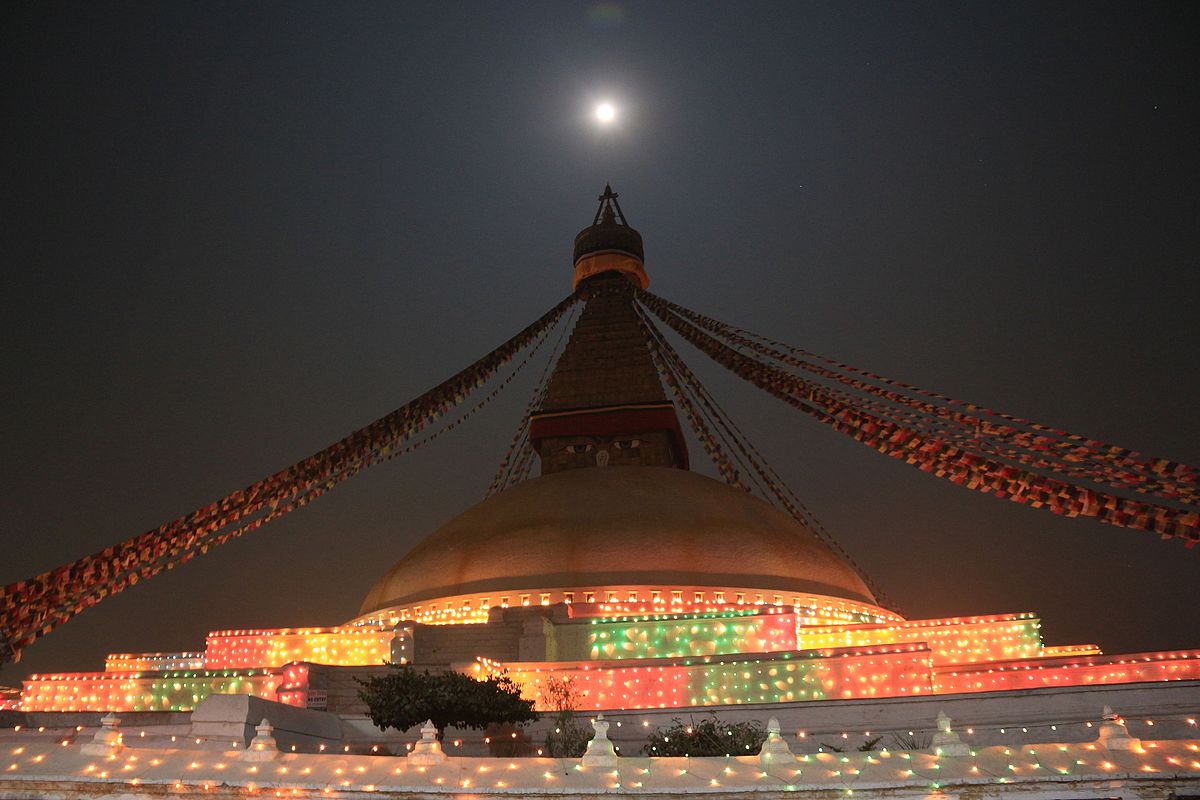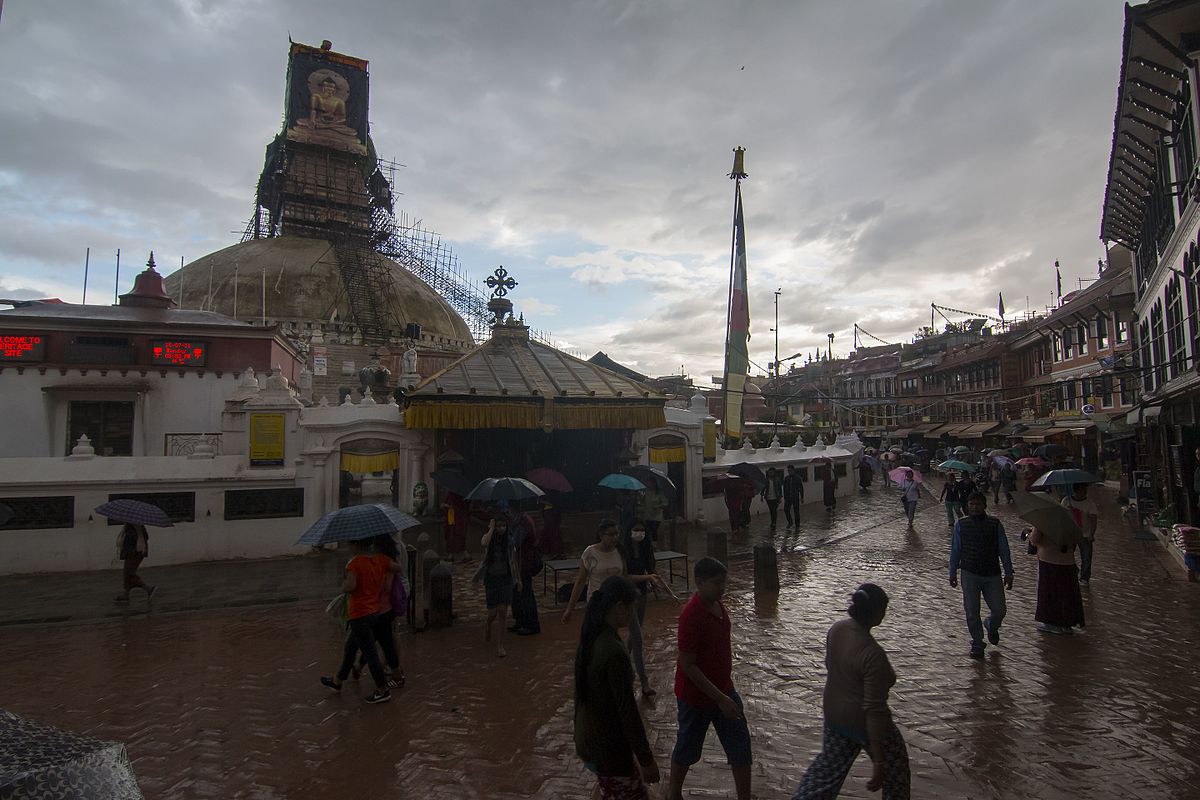Boudhanath Stupa - The Great Stupa in Nepal.

Boudhanath (Nepali: बौद्ध स्तुपा, also called the Khasa Chaitya, Newari Khasti, Standard Tibetan Jarung Khashor, Wylie: bya rung kha shor) is a stupa in Kathmandu, Nepal. Located about 11 km (6.8 mi) from the center and northeastern outskirts of Kathmandu, the stupa's massive mandala makes it one of the largest spherical stupas in Nepal.

The Buddhist stupa of Boudha Stupa dominates the skyline; it is one of the largest unique structure's stupas in the world. The influx of large populations of refugees from Tibet has seen the construction of over 50 gompas (Tibetan convent) around Boudha. As of 1979, Boudha Stupa is a UNESCO World Heritage Site. Along with Swayambhu, it is one of the most popular tourist sites in the Kathmandu area.

The Stupa is on the ancient trade route from Tibet which enters the Kathmandu Valley by the village of Sankhu in the northeast corner, passes by Boudha Stupa to the ancient and smaller stupa of Cha-bahi named Charumati Stupa (often called "Little Boudhanath"). It then turns directly south, heading over the Bagmati River to Lalitpur - thus bypassing the main city of Kathmandu (which was a later foundation). Tibetan merchants have rested and offered prayers here for many centuries. When refugees entered Nepal from Tibet in the 1950s, many decided to live around Boudhanath. The Stupa is said to entomb the remains of Kassapa Buddha.
Legend of the construction of the stupa according to Newar Buddhist mythology

According to the history of Nepal, the palace of King Bikramaditya (Licchavi King) once stood where the Narayanhity Palace currently stands. King Vikramaditya instructed that a Dhunge Dhara should be built in the southern part of palace courtyard. But there was no sign of water from the Dhunge Dhara, for which the king consulted Astrologers. Astrologers suggested that a Human sacrifice with a male candidate having Battis-Lakshanas, or thirty-two perfections should be performed. Only the king himself and his two princes were suitable candidates. So, the king decided to sacrifice himself and ordered one of his sons to sacrifice him so that sign of water could be seen at the Dhunge Dhara. According to local mythology, during the time of sacrifice, the head flew off to a place nearby Sankhu Bajrayogini Temple.
Stone made Head of King Vikramaditya in Bajrayogini

The Great Stupa
The prince then with a regretful heart, flew a hen from the top of Bajrayogini and decided to construct a Stupa where the hen landed. The hen landed in the place where Boudhanath Stupa is currently standing. During the same time, the place was struck with a Drought and the people managed to abate the scarcity of water by collecting the droplets of dew. So, the place was named Khasti as in Nepal Bhasa, "khas" refers to dew and "ti" refers to drops.
Later His Majesty Government of Nepal renamed the place from Khasti to Boudhanath in order to reflect Hinduism as being the Hindu Nation.
"The village that surrounds the great Kasyapa stupa is generally known by the name of Bauddha. ...which in Tibetan is called Yambu Chorten Chenpo (Tibetan: ཡམ་བུའི་མཆོད་རྟེན་ཆེན་པོ། Wylie: yam bu'i mchod rten chenpo). Yam is the general name by which Patan area is known in Nepal Bhasa, thus it's called Yembu even today in most part of the Himalaya and Tibet, and Chorten Chenpo means great stupa. The real name of the stupa in full is, however, Jya Lung Khashor Chorten Chenpo, literally which may be translated as "Chorten of Hens skin-rope breach promise" The stupa has an interesting history of its own which explains this strange name. It is said in this story that Kasyapa was a Buddha that lived a long time before Sakyamuni Buḍḍha. after Kasyapa Buddha's demise, a certain old woman-Ma-Jha-Zi-Ma who owned hens farm, with her four sons, interred this great sage's remains at the spot over which the great mound now stands, the latter having been built by the woman herself. Before starting on the work of construction, she petitioned the King of the time to grand a land size of a piece of skin and obtained permission to "proceed with" building a tower. the king was surprised how she going to build it on such a small size of land, and gave her both land and permission. She then carefully cut the skin and made skin-rope (lung) and circulate the area. Which become the size of present area of Bouddhanath. By the time that, as a result of great sacrifices on the part of the woman and her four sons, the groundwork of the structure had been finished, those who saw it were astonished at the greatness of the scale on which it was undertaken. Especially was this the case with the high officials of the country, who all said that if such a poor old dame were allowed to complete building such a stupendous tower, they themselves would have to dedicate a temple as great as a mountain, and so they decided to ask the King to disallow the further progress of the work. When the King was approached on the matter his Majesty replied: "I have finished giving the order to the woman to proceed with the work. Kings must not eat their words, and I cannot undo my orders now" which is known as (Kha-Shor), thus, the name came as Jya Lung Khashor. So the tower was allowed to be finished, and hence its unique name, "Jya Lung Kha-shor Chorten Chenpo." I rather think, however, that the tower must have been built after the days of sakyamuni Buddha, for the above description from Tibetan books is different from the records in Sanskrit, which are more reliable than the Tibetan." the biggest stupa in Nepal.

History
The Gopalarajavamsavali says Boudhanath was founded by the Nepalese Licchavi king sivadeva (c. 590-604 CE); though other Nepalese chronicles date it to the reign of King Manadeva (464-505 CE). Tibetan sources claim a mound on the site was excavated in the late 15th or early 16th century and the bones of King Amshuvarma 605-621 were discovered there.
However, the emperor Trisong Detsen (r. 755 to 797) of the Tibetan Empire is also traditionally associated with the construction of the Boudhanath Stupa. The Yolmo Shakya Zangpo from Helambu resurrected Boudhanath.

The April 2015 Nepal earthquake badly damaged Boudhanath Stupa, severely cracking the spire. As a result, the whole structure above the dome, and the religious relics it contained had to be removed, which was completed by the end of October 2015. The reconstruction began on 3 November 2015 with the ritual placement of a new central pole or "life tree" for the stupa at the top of the dome.

Tags:
Monastery
Pilgrimage Sites in Nepal
Temples in Nepal
The Protected Areas of Nepal
UNESCO World Heritage Sites of Nepal

